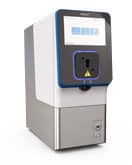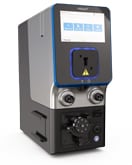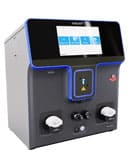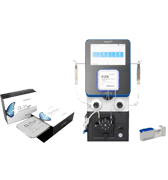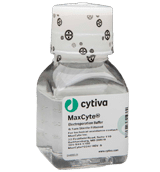Scientific Poster
Preclinical Optimization of Gene Editing for Adoptive T Cell Therapy with High Fidelity CRISPR/Cas9 Ribonucleoproteins
Abstract
Adoptive cell therapy with T lymphocytes harnesses the immune system for cancer treatment. T lymphocytes engineered with transgenic T cell receptors (TCR) specific for tumor antigens are in clinical development for various cancers. Knockout of endogenous TCR gene may improve expression of TCR transgene, and knockout of PD-1 may reduce T cell exhaustion induced by tumor expressed PD ligands. Gene editing with CRISPR-Cas9 via electroporation (EP) offers a rapid, clinically scalable approach for multiplexed knockout. High editing efficiency may reduce the timeline and cost of cell therapy manufacturing, and increase the proportion of edited cells. Additionally, editing with Cas9 ribonucleoprotein (RNP) may reduce off-target edits relative to Cas9 nucleic acid substrates, particularly with high fidelity Cas9. We transfected high fidelity Cas9 RNP (SpyFiTM Cas9 Nuclease, Aldevron®) into activated human T cells to knockout TCR using MaxCyte’s scalable, GMP-compliant electroporation technology. High editing efficiency was observed by flow cytometry using RNPs complexed with SpyFiTM or wild type enzyme (WT Cas9, Aldevron). Editing efficiency was dependent on RNP concentration and electroporation energy. Following electroporation, viability improvement and resumption of proliferation were observed within 5 days. Co-electroporation of RNPs directed to TCR alpha chain, TCR beta chain, and PD-1 resulted in dual knockout of TCR and PD-1, with comparable editing efficiency for WT or SpyFi RNPs. The frequency of off-target editing was compared at multiple genomic loci by next generation sequencing. Taken together, the results support editing of T lymphocytes lacking endogenous TCR and PD-1 with high fidelity RNPs.
Experimental Design

Figure 1. Gene editing of activated T Cells for adoptive cell therapy manufacturing.


Peripheral blood mononuclear cells (PBMCs) were thawed and cultured in human CD3/CD28 DynabeadsTM and IL2 for 3 days to activate and expand T cell populations. On the day of EP, RNPs targeting T cell receptor alpha chain (TRAC) were prepared by incubating sgRNAs at room temperature with WT SpCas9. Activated T cells (3.5x107-5.5x107 cells/mL) and RNPs were mixed and electroporated with the MaxCyte GTxTM and the R-50x8 processing assembly. Five days post EP, TCR expression was determined by flow cytometry to be considerably reduced compared to the no EP control.
Figure 2. Optimization of TCR knockout.



Following EP and cell expansion, TCR expression was evaluated by flow cytometry; cell viability and expansion were measured using acridine orange and propidium iodide staining. A) TCR expression in all the tested parameters was reduced to 81%-91% of the no EP control. B) Similar cell viabilities (73%-80% live cells) 7 days post EP were attained for all the tested RNP concentrations and EP conditions. C) Cells had resumed proliferation 4-5 days post EP and expanded several fold 7 days post EP (3.6-fold - 7.2-fold expansion from day 1).
Figure 3. High TCR knockout efficiency with WT and SpyFiTM RNPs



A) To compare the knockout efficiency of TRAC RNPs prepared with either WT or SpyFi RNPs, TCR expression and cell viability were measured 5 days post EP by flow cytometry. TCR expression was considerably reduced with all RNPs used and high cell viability was maintained. B) At the genetic level, TRAC knockout was assessed by sequencing 13 days post EP. Genomic DNA was extracted, and the region of the TRAC locus flanking the CRISPR cut site was amplified by PCR, gel-purified, and sequenced by Sanger sequencing followed by Inference of CRISPR Edits (ICE, Synthego) analysis or by next generation sequencing (NGS). Gene knockout was comparable between both RNPs. C) Results from ICE analysis of sanger sequences were similar to results obtained by NGS.
Figure 4. Fewer off-target events with SpyFiTM vs. WT RNP.




The frequency of off-target editing for each RNP was determined by measuring InDel percentages at 4 off-target binding sites previously identified by iGUIDE1. DNA flanking off-target binding sites in CLIC2, LDAH, ANKS1B, and ADCY10 were amplified by PCR, gel-purified, and sequenced by NGS. A) At the CLIC2 locus SpyFi RNP reduced off target editing by 94% compared to WT RNP. B) Similarly, at the LDAH locus there was an 87% reduction in off-target editing. At both these loci SpyFi had off-target effects comparable to no EP controls. C,D) At the other 2 sites (ANKS1B and ADCY10), off-target editing was generally less frequent but was diminished with SpyFi (33% less at ANKS1B locus, 15% less at ADCY10.) Quantification of off-target editing is on-going for No EP control cells at ANKS1B and ADCY10 loci.
Figure 5. High multiplexed knockout efficiency with WT and SpyFi TM RNP

Knockout of the PD-1 receptor in addition to TCR may further improve performance of T cells for adoptive cell therapy by limiting onset of T cell exhaustion. To knockout both TCR and PD-1, activated T cells were electroporated with an equimolar mixture of RNP targeting TRAC, TRBC, and PD-1. Expression was measured by flow cytometry 5 days post EP. Expression was substantially reduced following EP with WT or SpyFi RNPs compared to no EP cells.
Summary
- Non-viral engineering using MaxCyte® Electroporation and Aldevron® Cas9 proteins enables rapid development of adoptive cell therapies with the benefit of simplified, more cost-effective manufacturing.
- MaxCyte electroporation technology can be used to co-transfect multiple CRISPR RNPs with high knockout efficiencies for T cell engineering.
- Development and optimization of electroporation for difficult-to-engineer primary cells is a rapid, straightforward process with the MaxCyte R-50x8 processing assembly.
- Aldevron’s SpyFiTM and WT RNPs had similar efficiencies when targeted to therapeutically relevant loci.
- Aldevron’s SpyFiTM Cas9 Nuclease reduces off-target editing events.
Reference
Stadtmauer EA, Fraietta JA, et al. CRISPR-engineered T cells in patients with refractory cancer. Science. 2020;367(6481). Published 2020 Feb 28 doi: 10.1126/science.aba7365
